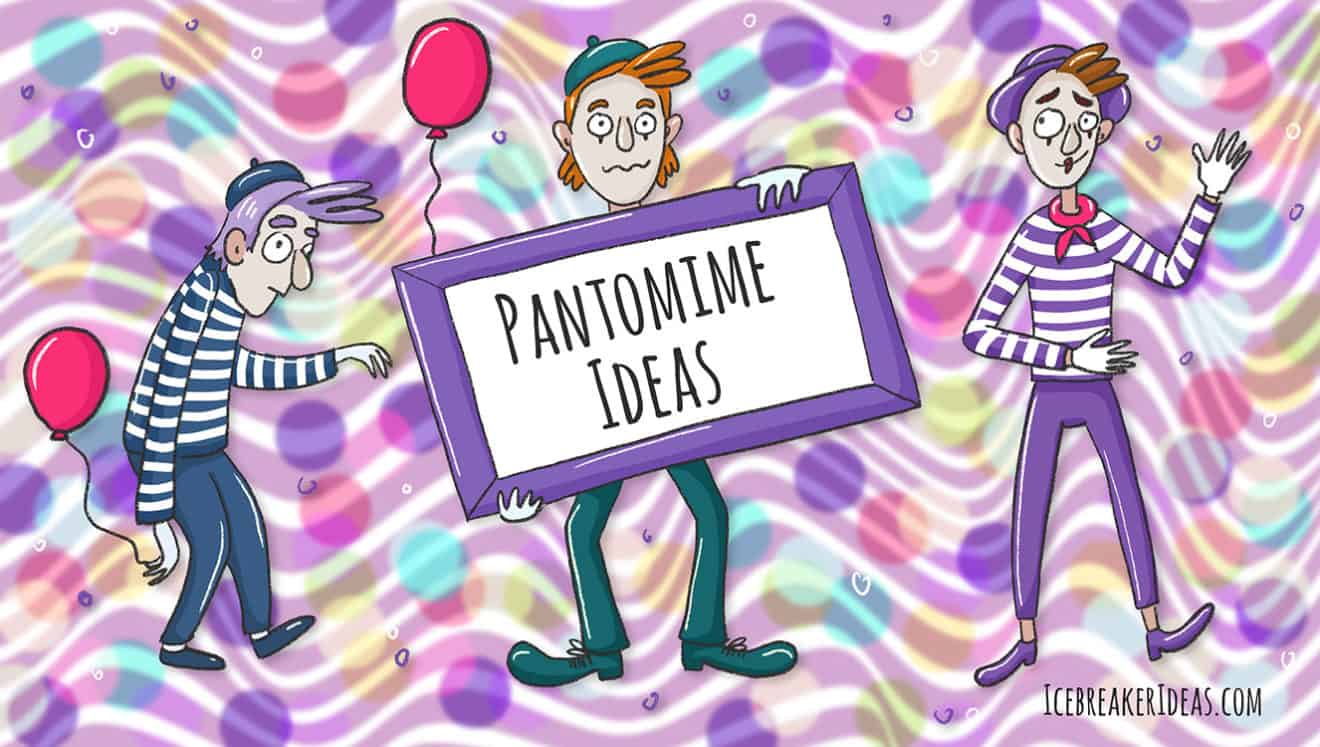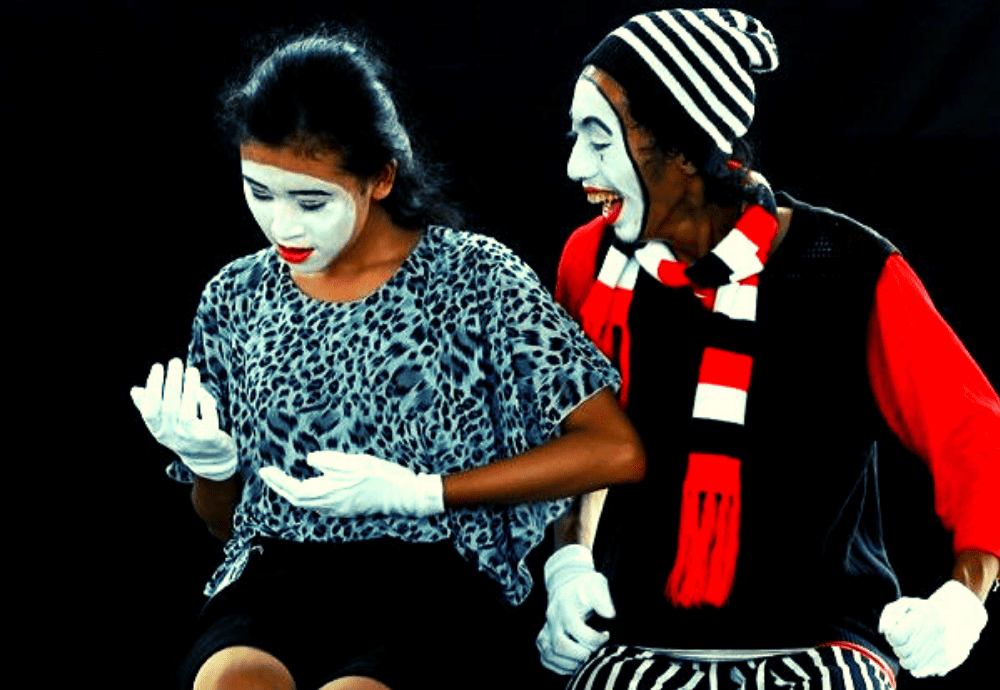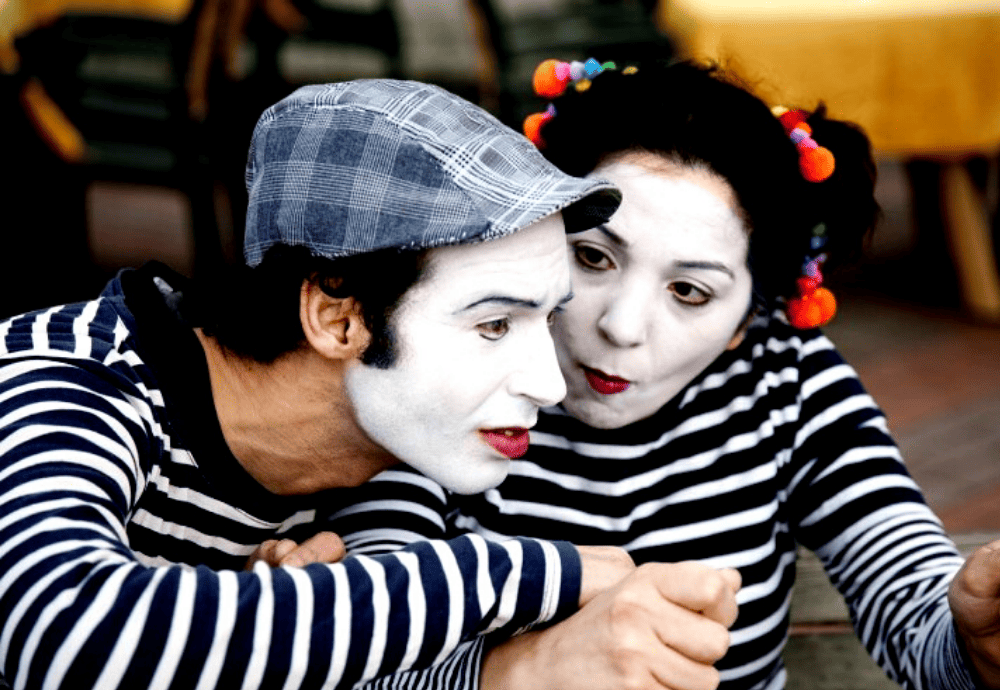Pantomime involves conveying a story with only bodily movements. The mime exaggerates movements and facial expressions. The goal is to portray personality characteristics and emotions to create believable scenarios. There are many benefits to pantomiming, among them the following:
Table of Contents
- Build self-confidence
- Increase self-expression
- Increase body awareness and control
- Promote inventiveness and imagination
We begin this article with many helpful ideas and tips to get you started pantomiming. We also have a great collection of pantomime games and activity ideas for you.
Pantomiming Tips
The goal is to make a realistic pantomime. To do so, try the following:
- Begin with the familiar and simple.
Choose a personality trait or activity with which you are comfortable and familiar. When you know exactly how something is done or a particular emotion feels, you can make your pantomime smooth and believable. - Practice different personality and character traits. Begin with one of the following:
Confident and self-assured – chest out, head held high, firm, confident steps with shoulders held back
Clumsy – trip or stumble; run into imaginary objects
In Love – a dreamy expression, hands over heart or reaching out
Shy – look at the ground, shuffle feet, and hunch shoulders
Evil or mean – move stealthily with a wicked smile and raised eyebrows - Learn how to realistically use pretend objects as props.
Every object, even the smallest, takes up space and has weight. Not only your hands and arms are used to convey the idea of a prop, but your body language should also indicate the weight and size of the object. - Practice in front of a mirror.
Use a large mirror to help make body movements more exact and a small mirror for facial expressions. Make sure transitions from one expression to another are sudden and well defined.
Pay attention to your hands and how your body moves. You can also have a friend videotape you.
When one is pantomiming, there are some relatively simple changes that can be made that will radically change the character of the activity which is being pantomimed. - Change the shape or kind of movement.
This involves changing the entire movement as with a change from a run to walk, or changing just one component, for example, from an open hand to a fist. - Change in the size of a movement.
If one takes a wide step as opposed to a narrow step, a high movement or one low down, walking on tiptoe, or stomping, this changes the entire character of the activity being pantomimed. - Change the direction of a movement.
A movement can lazy and aimless, or direct and specific. - Change the focus of a movement.
This applies to facial expression and where the pantomime is looking – down, off into the distance with eyes shaded, at the audience or away. - Change the tension of the movement.
The muscles can be tense or relaxed. Fluid movement creates a different impression than jerky, quick movement. - Change the timing of the movement.
A movement can be slow or fast. This applies to bodily and facial movements. - Change the weight of the movement.
Weight can either refer to the passing or holding of an object or actual movement, as in jogging as a light weight person and as someone heavier.
Pantomime Games
Pantomiming, considered an art form, also works as a game. Use our pantomime games in the corporate environment as a team building exercise, at parties, for drama classes in schools, and for training in community theatres. We have some pantomiming takes on familiar games and some original game ideas to keep you occupied and challenge your imagination while having fun.
Follow the Leader
Pantomiming works perfectly with a traditional game of Follow the Leader. The group stands or sits in a circle, with one person standing in the middle. The person in the middle closes their eyes and the rest of the group chooses one person as the leader. The leader pantomimes a situation or activity slowly and clearly. The rest of the group follows the leader as quickly and precisely as they can. The person in the middle tries to discern who the leader is. When they do so, another person takes the middle position and the game starts over.
Pass It
Have everyone sit in a circle. Collect a few items of various sizes to pass around. After each item is passed, direct the group to pantomime passing the object without talking. Instruct them to pantomime realistically; keep the object from falling, indicate size and weight, and, if appropriate, smell and touch. Use our list of objects below or choose some of your own:
- An egg
- A plate
- A glass full of water
- A piece of fruit
- A bead
- A leaf
- A pencil or pen
- A brick or heavy rock
Join In
Quick and short pantomimes begin when one person starts pantomiming an activity. One by one the others in the group join in until everyone is pantomiming the same activity. Once everyone is participating, a new activity starts. Remind your players not to speak. Use one of the following activities or choose your own:
- Trying to open a stuck window or door
- Eating a banana or another type of fruit
- Putting on shoes and socks
- Riding in the car with someone else
- Walking in the rain or snow
- Boarding an airplane or train
- Washing a dog
- Taking a shower or bath
Charades
Probably the most familiar pantomiming game is Charades. Beginning players and very young children should be given simply activities to act out, such as mowing the lawn or sweeping the floor. Adults and more experienced players can act out more sophisticated activities. Before you begin playing, pass out notecards to the participants and have them write down suggested activities. Additionally, you can have players pantomime book and movie titles, famous people and events, and other categories limited only by your imagination. Whoever correctly guesses what it being pantomimed is the next person to pantomime in front of the group.
Animal Antics
A fun and sometimes silly game, Animal Antics has each player choose an animal and pantomime their characteristics. The other players guess what animal is being pantomimed. The first one to guess takes the next turn. Try one of the animals listed below, or choose your own:
- Dog
Get on hands and knees, pant, stick out tongue, beg, chase, a stick, prance around on all fours. - Snake
Lie on the floor and slither around - Rabbit
Get on hands and knees, bend arms at the elbow and put forearms on the floor. Make hopping motions and wiggle the nose. - Cat
Pretend to lick fur, lap milk, and arch back as if asking for a rubbing. - Bird
Flap imaginary wings, soar, and pretend to eat a worm.
Group Pantomime Ideas
The word pantomime is derived from the Latin word panto meaning gestures used to support a theme. Mime is derived from the Greek word mimesis meaning to imitate an activity. We have some clever group pantomiming ideas for those who are just beginning and those who are experienced at pantomime. Enjoy!
Face to Face
Have your group stand in a circle. Choose a person to begin the pantomiming exercise by making a face to convey a specific emotion or feeling to the person on their right. Each person in the circle does the same to the person to their right, attempting to pantomime a unique and different emotion. The goal is to change faces quickly and smoothly. Continue until all players have taken a turn. Consider the following emotions or choose some emotional situations of your own:
- Love
- Hate
- Indifference
- Fear
- Caution
- Fatigue
- Excitement
- Joy
Tug of War
Pantomiming a game Tug of War helps create a variety of realistic movements and positions. Your arms and hands pretend-hold a rope. Your body assumes a squatting position with legs braced, and moves forward and backward as the imaginary rope tightens and loosens. You must be aware of your feet, legs, hips, shoulders, and arms. Your head must be in the right position. Remember, you want to give the impression that you are pulling on a rope, so strain your muscles.
Guess What
Divide your group into teams of four to six people. Instruct them to pantomime an activity. Remind them that they cannot speak, but must use only their bodies and facial expressions. Have each group decide on roles to play, actions, and ideas and then have them present their activity to the rest of the group, who will guess what activity is being performed. Create your own list or suggest one of the following if you wish:
- Playing a sport (throwing or catching a ball, running bases, etc.)
- Working in a fire station (sliding down the pole, jumping on the fire truck, holding a hose, etc.)
- Learning in a classroom (teacher and students)
- Working in an office (typist, answering the phone, delivering mail, etc.)
- Weeding and planting flowers in the garden.
Mirror Movements
Divide your group into pairs and have them face each other. One person pantomimes an action and the other mirrors or matches their partner exactly. Movements can be crazy, reflect a certain emotion, or imitate an activity. Remind those pantomiming to involve all of their bodies and their faces. After a reasonable amount of time, have the partners change who is performing and who is mirroring.
Pantomime Activity
Here you will find a selection of pantomime activities. Pantomime activities provide both adults and children the opportunity to learn about body language and the messages we send to others. Pantomiming is always active, however these activities call for a high level of physical involvement.
Imagine If
Set up two chairs as an imaginary doorway in the front of the room. One by one, have each person pantomime an imaginary event. Have a person exit the room and re-enter pantomiming the chosen event. The rest of the group guesses what activity is being portrayed. You can have your group choose their own activities or use one of the suggestions listed below:
- Breaking up with a boyfriend or girlfriend.
- Getting a new car.
- Meeting a famous person.
- Having their purse/briefcase snatched.
- Riding a bus standing up because all the seats are taken.
- Participating in a sport (baseball, football, bowling, swimming, etc.)
Activity Guess
An activity similar to Imagine If, for this one you have each person pantomime an activity. Begin by having your participants brainstorm a list of activities, writing them on slips of paper as they do so. Then have each person take a turn selecting a random activity to present. The following suggestions will get our group started.
- Sweeping a floor.
- Completing the sale of an item.
- Washing the car.
- Changing a diaper.
- Folding laundry.
- Changing a tire.
If you wish, you can also turn this into a group activity. Have one person begin miming the activity and as those watching guess the activity, have them join in until the entire group is pantomiming the activity together.
Feelings
Effective pantomiming not only involves deliberate body movement, but also facial expressions. You need to think about how your face looks when experiencing a certain emotion and then multiply it significantly. Consider the following suggestions:
- Happiness
Think happy thoughts so that your eyes convey joy. Have a wide smile and add raised eyebrows. - Surprise
Think “Oh!” or “Wow!” and shape your mouth in an o with eyebrows raised and hands help up in surprise. - Sadness
Think sad thoughts with a downturned smile or frown, with head hung down and sorrow filled eyes. - Anger
Convey anger with taut muscles and fast body movements. Add hands clenched into fists.
Have your group take turns conveying emotions with the other group members guessing which emotion is being portrayed. The first person to guess correctly takes the next turn.
Movement Mime
Before this activity, prepare a set of movement cards, each containing the second half of a sentence. Included with each suggested sentence half below are some ideas on how to pantomime the situation.
- through a rain storm, looking for your lost dog.
- across a wide river on a boat in a storm.
- to school on a snowy morning.
- down a dark alley, looking for and finding a dead body.
- through a forest at night when you are lost and afraid.
- to the kitchen at night to get a snack from the refrigerator.
- along the beach looking for and finding shells.
- down a park path on a sunny day.
- across a stage and bowing in front of an audience.
The first part of the sentence is one of three types of movement:
- I am walking . . .
- I am running . . .
- I am crawling . . .
Each person chooses a card and pantomimes with their choice of movement. This activity is great fun and very entertaining.
Pantomime, the subtle art of over-exaggeration becomes effective when one remembers to:
- Face the audience at all times, unless turning your body away is part of the activity or emotion you are trying to convey.
- Involve all of your body parts and don’t forget facial expressions.
- Watch your audience and their responses and tailor some of your movements to their reactions.
- Practice, practice, practice. The more you pantomime, the better you will become.
Pantomiming not only works well for drama clubs and activities, but as a fun party or team building game. Use the suggestions in this article to learn the skill of effective pantomiming. Mime on and have fun!
Susan majored in English with a double minor in Humanities and Business at Arizona State University and earned a Master’s degree in Educational Administration from Liberty University. She taught grades four through twelve in both public and private schools. Subjects included English, U.S. and world history and geography, math, earth and physical science, Bible, information technologies, and creative writing.
Susan has been freelance writing for over ten years, during which time she has written and edited books, newspaper articles, biographies, book reviews, guidelines, neighborhood descriptions for realtors, Power Point presentations, resumes, and numerous other projects.





Thank you so much for writing this article. I have been working on putting together a drama class for our Middle School. This information has been very helpful.
This has been so helpful and useful. Lots of great ideas! This is really going to help with my group! Thank you so much.
Kind regards
Karen Booth